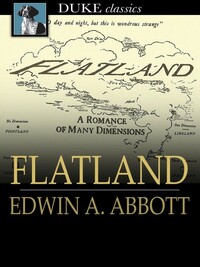Take a photo of a barcode or cover
adventurous
reflective
slow-paced
Plot or Character Driven:
Plot
Strong character development:
Yes
Loveable characters:
Complicated
Diverse cast of characters:
No
Flaws of characters a main focus:
No
reflective
medium-paced
Plot or Character Driven:
A mix
Strong character development:
No
Loveable characters:
Complicated
Diverse cast of characters:
No
Flaws of characters a main focus:
No
This is a rare book to find, but was inspiration for one of my favorite authors (Jasper Fforde) so I sought it out. As someone who studies three-dimensional shapes/structures of proteins, it was so fun to read about perspectives on life.
This was...an interesting read. Totally aside from the exploration of dimensions, which was really fascinating (what would a two dimensional being see? a one dimensional? no dimensions?), this was a really interesting commentary on Victorian culture (I had the annotated version, so I was able to read the plethora of footnotes.).
It taught some interesting geometry concepts, but the most interesting part is the Flatlanders' reaction to the 3 dimensional beings who visit. This include, but are not limited to, intense state secrets, locking people into asylums (or even straight up executing them). At one point, they switch out some Isosceles guards for "lower class" Isosceles guards, knowing in advance that they are going to kill them. The classism is real, yo.
It also has interesting exploration of women's roles in Victorian culture, and hints (only hints, not calls for any change) at the idea that, "maybe, just maybe, we're not educating women properly, and are severely underestimating them." Progressive, for the time at least.
Ultimately, this is hella short, and totally worth sitting down with. I read it in two evenings, and that was while going down the rabbit hole of annotations that go on for 2-3 pages.
It taught some interesting geometry concepts, but the most interesting part is the Flatlanders' reaction to the 3 dimensional beings who visit. This include, but are not limited to, intense state secrets, locking people into asylums (or even straight up executing them). At one point, they switch out some Isosceles guards for "lower class" Isosceles guards, knowing in advance that they are going to kill them. The classism is real, yo.
It also has interesting exploration of women's roles in Victorian culture, and hints (only hints, not calls for any change) at the idea that, "maybe, just maybe, we're not educating women properly, and are severely underestimating them." Progressive, for the time at least.
Ultimately, this is hella short, and totally worth sitting down with. I read it in two evenings, and that was while going down the rabbit hole of annotations that go on for 2-3 pages.
dark
informative
reflective
medium-paced
I loved the math and geometry angle used by the author to communicate political commentary. However, the book format is what kept it from a higher rating from me — the first 50% was all worldbuilding with little to no plot, and then the second half of the novella was plot (albeit not very much plot). I may read it again someday, but the lack of compelling characters and plot made it less intriguing of a book overall.
slow-paced
Strong character development:
No
Loveable characters:
No
Diverse cast of characters:
No
Flaws of characters a main focus:
Complicated
It's sort of like reading a math book with characters, but surprisingly enough I enjoyed it! There are also obvious narratives about social class and gender, but I didn't take these too seriously since the story was originally written in 1884.
I read the SciFi/satire book Flatland: A Romance of Many Dimensions is a satirical novella by the English schoolmaster Edwin Abbott Abbott, first published in 1884. Written pseudonymously by "A Square", the book used the fictional two-dimensional world of Flatland to comment on the hierarchy of Victorian culture, but the novella's more enduring contribution is its examination of dimensions.
Physicists and science popularizers Carl Sagan and Stephen Hawking have both commented on and postulated about the effects of Flatland. Sagan recreates the thought experiment as a set-up to discussing the possibilities of higher dimensions of the physical universe in both the book and television series Cosmos, whereas Hawking notes the peculiarity of life in two-dimensional space.
A must-listen classic for lovers of science fiction!
Physicists and science popularizers Carl Sagan and Stephen Hawking have both commented on and postulated about the effects of Flatland. Sagan recreates the thought experiment as a set-up to discussing the possibilities of higher dimensions of the physical universe in both the book and television series Cosmos, whereas Hawking notes the peculiarity of life in two-dimensional space.
A must-listen classic for lovers of science fiction!
reflective
medium-paced
Plot or Character Driven:
Plot
Strong character development:
Complicated
Loveable characters:
No
Diverse cast of characters:
Complicated
Flaws of characters a main focus:
Yes





